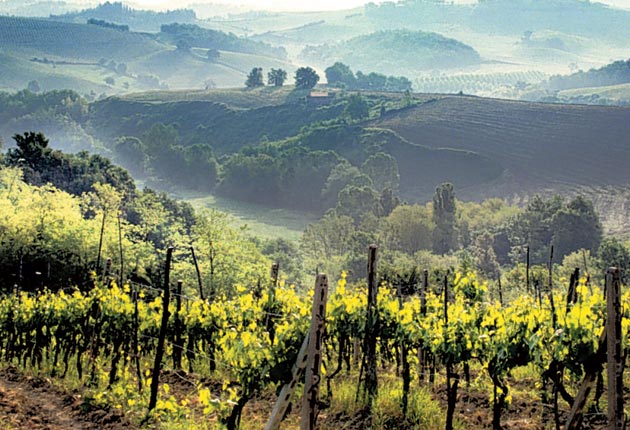European wines are flavour of the month once again

Your support helps us to tell the story
From reproductive rights to climate change to Big Tech, The Independent is on the ground when the story is developing. Whether it's investigating the financials of Elon Musk's pro-Trump PAC or producing our latest documentary, 'The A Word', which shines a light on the American women fighting for reproductive rights, we know how important it is to parse out the facts from the messaging.
At such a critical moment in US history, we need reporters on the ground. Your donation allows us to keep sending journalists to speak to both sides of the story.
The Independent is trusted by Americans across the entire political spectrum. And unlike many other quality news outlets, we choose not to lock Americans out of our reporting and analysis with paywalls. We believe quality journalism should be available to everyone, paid for by those who can afford it.
Your support makes all the difference.After a decade of falling sales, European wines are staging a comeback against the full-bodied fruity blockbusters from Australia and America.
British drinkers bought an extra 20 million bottles of chablis, chianti and rioja and other styles from the leading "Old World" countries while the two New World superpowers lost market share, market research reveals.
Growth has been particularly strong for Spain and Italy, both up 10 per cent, a combined £96m, during the last half of 2009 and first half of 2010, according to figures from the analysts AC Nielsen.
They show that France lost 2 per cent of its sales during the period.
A range of factors are behind the revival of interest in Europe's vineyards, say experts, including a greater interest in provenance and authenticity and a trend for buying wines to accompany home-cooked meals during the downturn. Changes in exchange rates – the Australian dollar is high and the euro relatively low – have also made European wine more affordable.
Although sales for several New World states such as Chile and New Zealand have also recorded strong growth, they start from a lower base than Australia and the US, which have dominated the UK trade with a winning formula of big brands, bold flavours and low prices.
For the 12 months to 15 May Australian wine sales edged up only £7m to £1.1bn, meaning its share shrank by 4 per cent to 21.2 per cent. The US fared even worse, slipping by £23m to £764m, shedding 5.3 million bottles and 6 per cent of its market share.
By contrast, France lost 2 per cent of its sales to £728m, but Italian wine surged by £61m to £668m, up 14 million bottles, and Spanish wine by £35m to £368m, a rise of 8.2 million bottles.
Two New World countries also fared well: Chile, the big success story of the past five years, put on £87m of sales to £464m and, helped by its grassy sauvignon blancs, New Zealand added £64m to £246m.
Julian Dyer, senior wine buyer for Sainsbury's, said: "We are seeing a stronger growth in Italian and French wines, rather than most New World countries, and that's a complete reversal of the trends we've seen for the last 10 years. Partly that's due to particular products and vintages but also because there's a resurgence of interest in the old-fashioned, classic wines."
Retailers were concentrating on making Old World wines easy to buy with labelling explaining the grapes used and the resulting flavour. "One of the challenges around the Old World is that they are complex wines with funny names that are difficult to pronounce and it's important we present them in a way that is easy to understand, explaining what's in them and what they will taste like," Mr Dyer said.
He said that French and Italian wines had recorded annual rises of over 10 per cent.
Simon Field, a fine-wine expert at the London merchant Berry Brothers, said that while the likes of Jacob's Creek, Blossom Hill and Gallo remained popular with British drinkers, Old World wine makers had been able to borrow some of New World's techniques such as stainless steel vats, to enhance consistency, without losing the complexity and elegance of the fruit from old vines.
He said: "I think fundamentally the move has been against the fruit-bomb style."
Best Old World Wines by Richard Ehrlich
These wines are a good place to start:
France
Domaine de l'Aumonier 2008, Touraine £8.95, Stone Vine & Sun, 01962 712351, www.stonevine.co.uk
A cracking Sauvignon Blanc from the Loire, fresh, crisp and full of beguiling citrus flavours.
PH Wine Cuvée Balthazar 2007, £9.99, Waitrose
Fantastic Syrah from the Languedoc, with depth to compete with some Rhône more expensive counterparts.
Italy
Tesco Finest Nero d'Avola 2008, £6.49, Tesco
Sicily is making full use of this potentially outstanding grape variety. Deep and rich in colour and flavour.
Sainsbury's Taste the Difference Gavi 2009, £7.99, Sainsbury's
Extraordinary quality for a Gavi at this price: these Piemontese whites don't often come cheap. Complex but fresh on the palate.
Spain
Tesco Finest Old Vines Tempranillo 2008, £6.99, Tesco
Spain's greatest red grape variety (the backbone of Rioja). Fat, rich, spicy.
Torres Viña Esmeralda 2009, £7.49, Waitrose and Majestic
A Moscatel/Gewürztraminer blend. Flowery, with the typical lychee flavour.
Join our commenting forum
Join thought-provoking conversations, follow other Independent readers and see their replies
Comments